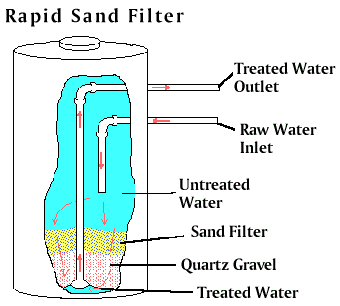Silca uses
Water filtration
Introduction and History
Silica sand has long been used to clean and purify water. The earliest recorded use of a sand filter dates back to 1804 when John Gibb designed and installed an experimental filter. This method of filtration was refined during the following two decades, culminating with the installation of the worlds first treated public water supply by James Simpson for the Chelsea Waterworks Company in 1829.
The practice of water treatment became mainstream after the physician, John Snow, made a connection between the quality of water and incidences of Cholera in 1845/55. The Metropolis Water Act was introduced and for the first time there were minimum standards for water quality, requiring that water be ‘effectually filtered’ from 31st December 1855. Today, the provision of good quality potable water is taken for granted in much of the developed world.
How does it work?
The natural silica filtration grade sands have a sub-angular to rounded shape, making them an ideal filtration media to capture suspended solids in water. Due to the high silica content, the sand is extremely durable and hard-wearing, allowing it to be precisely graded to facilitate efficient filtering.
Four grades of silica sand are used for water filtration in the UK today, these are 6/14, 8/16, 14/25 and 16/30. The silica sand is usually laid on top of a supporting layer of gravel within the filter vessel. The incoming water enters the filter and migrates through the silica sand, successfully removing any solids or debris from the water.
Applications
Because of its unique properties, silica sand is used for water filtration in a wide variety of applications including potable and waste water treatment, swimming and leisure, brewing, paper processing, chemical processes and power generation.
Types of Filter
Pressure filters
Pressure Filters are typically operated with a feed pressure of 2 to 5 bar and are commonly used in leisure applications. The feed water enters the filter and passes (under pressure) through a bed of silica sand. The majority of the particulate solids are captured higher up in the filter bed, this type of filter is capable of capturing very small particles. The build-up of particulate solids causes an increase in the pressure loss across the bed for a given flow rate. When the pressure loss or flow rate is unacceptable the bed is back washed to remove the accumulated particles. Small amounts of sand can be lost in the back washing process and the bed may need to be topped up periodically.
Rapid gravity filters
Rapid Gravity Filters are often used for water purification, most commonly at drinking water treatment works. RGF’s require smaller land areas compared to slow sand filters and use silica sand and other granular media to remove particles and impurities, typically with the addition of a flocculant. RGF’s must be cleaned frequently to maintain flow rate, often several times a day, by backwashing. During backwashing, the bed is fluidized with water and compressed air, care must be taken not to wash away the filtration media during this process.

RGF’s typically form part of multi-stage water treatment systems and are used by the large water authorities. These systems offer high flow rates but are complex and expensive to operate and maintain.
Slow sand filters
Slow Sand Filters are used in water purification for treating raw water to produce a potable product. They are typically 1 to 2 metres deep, their size determined by the flow rate desired from the filter. Due to their low filtration rates, slow sand filters require an extensive land area, as a consequence, many cities have now switched from Slow Sand Filters to Rapid Gravity Filters due to increased demand for drinking water and limited availability of land.
Slow sand filters differ from all other filters used to treat drinking water in that they work by using a complex biological film (hypogeal or Schmutzdecke) that grows naturally on the surface of the sand. The sand itself does not perform any filtration function but simply acts as a substrate.
As they require little or no mechanical power, chemicals or replaceable parts, and minimal operator training, Slow Sand Filters are often an appropriate technology for poor and isolated areas and are recognised by the World Health Organization and United Nations as being the cheapest, simplest and also the most efficient method of water treatment. |

